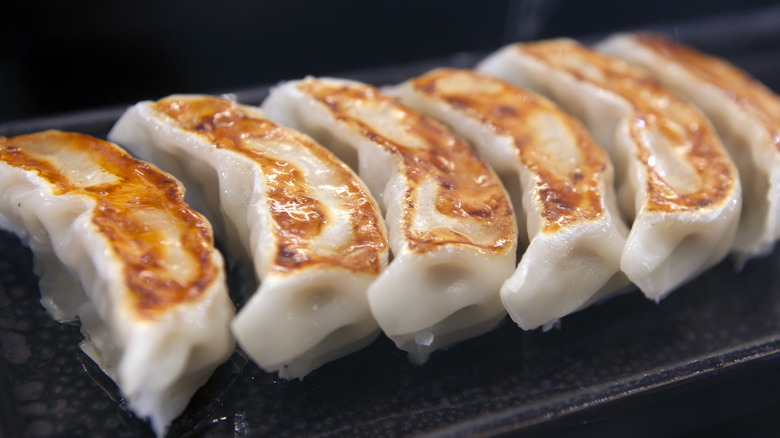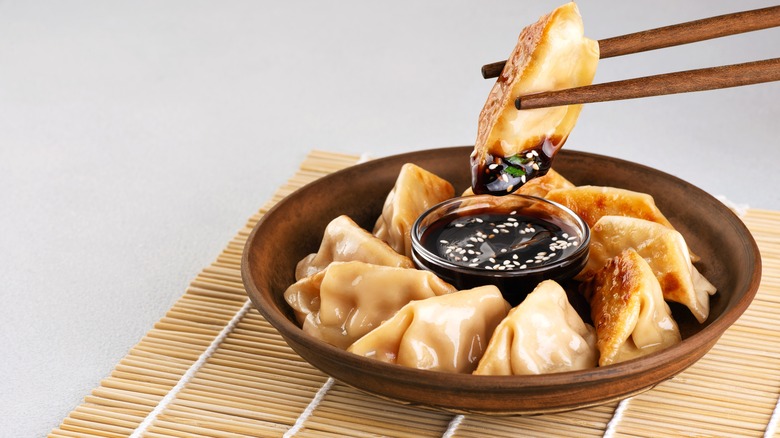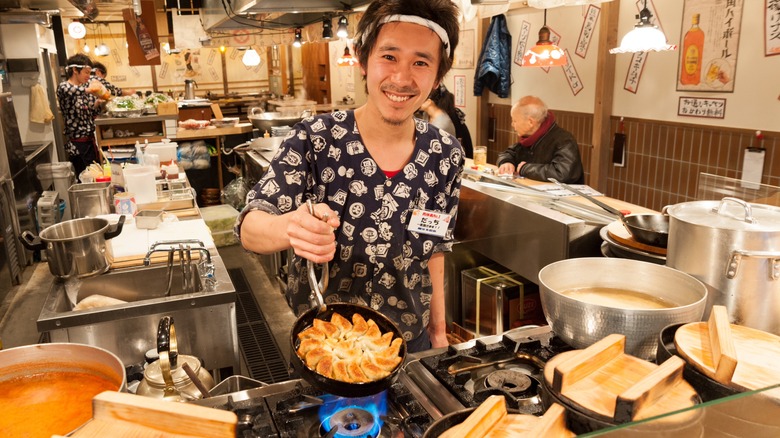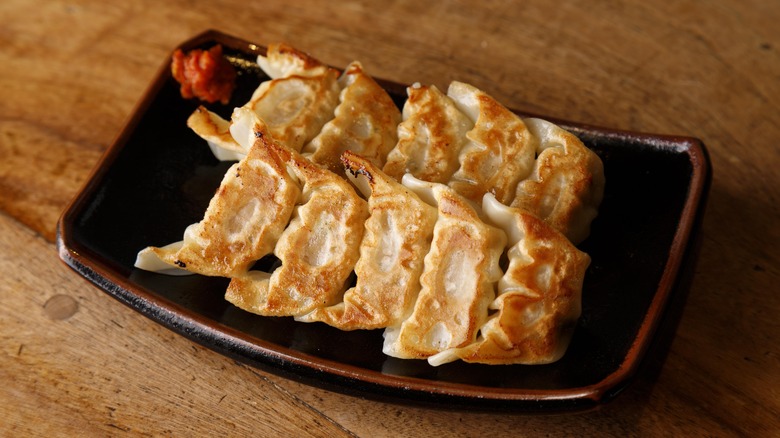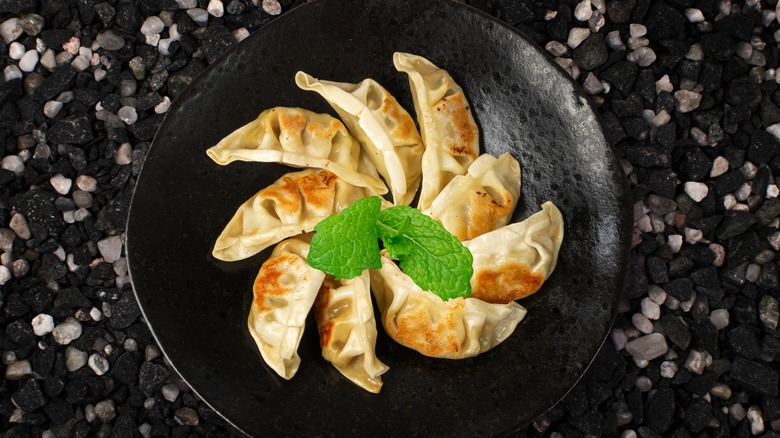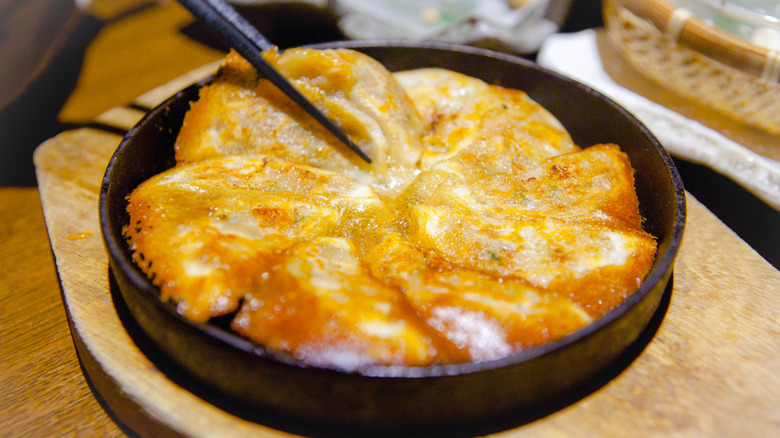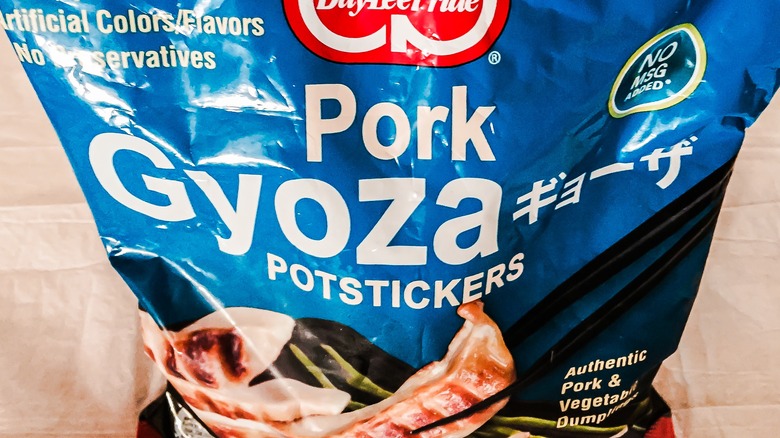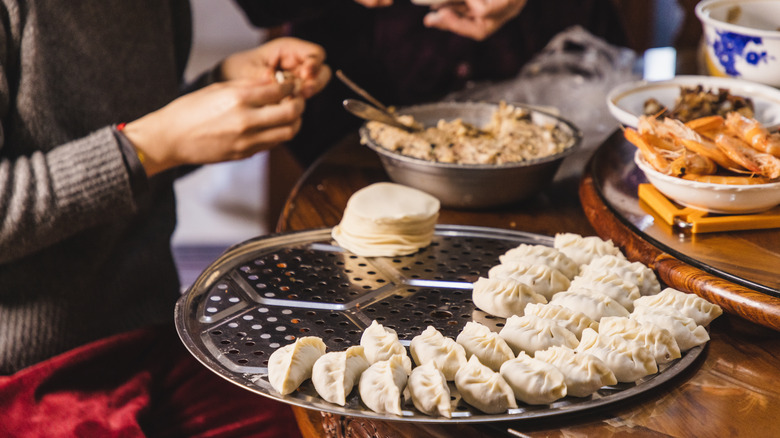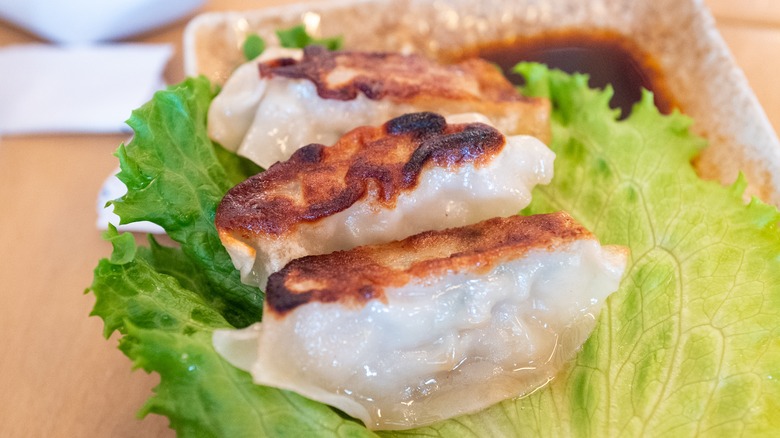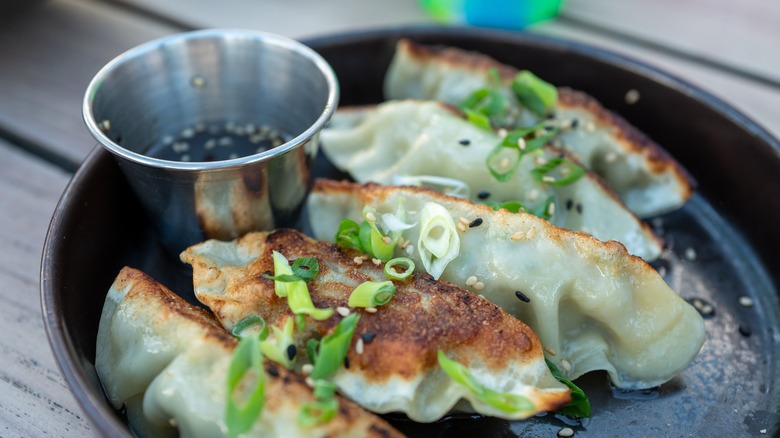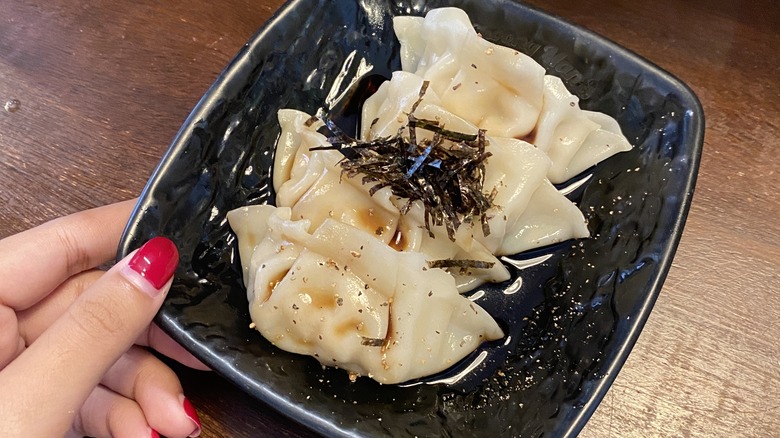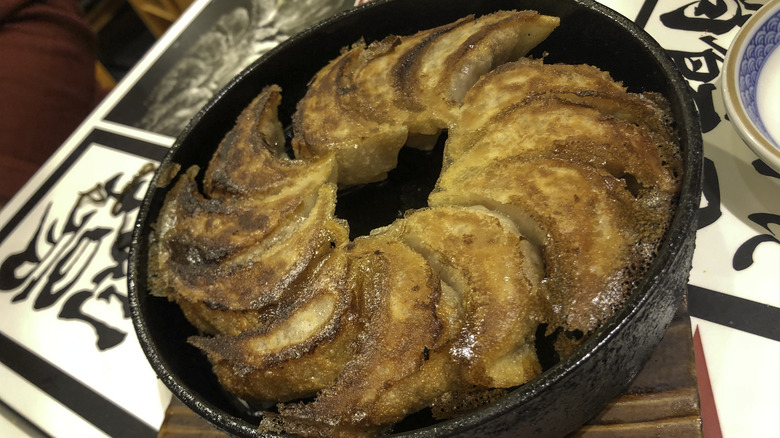What Are Gyoza? Japan's Favorite Dumplings, Explained
In Japan, when a craving for a satisfying but affordable meal hits, both locals and savvy visitors turn to a familiar favorite: gyoza, hearty pleated dumplings with succulent fillings of meat, vegetables, or a combination of both. They're not only tasty but easy to chow down — just ask legendary competitive eater Joey Chestnut, who broke a world record by inhaling 384 of them in 10 minutes in 2014. And if you're already a gyoza lover who can't get enough, Tokyo restaurant Kagurazaka Hanten has a deal for you: a gyoza at 2.5 kilograms (5.5 pounds) that's yours for free, along with bragging rights, provided you eat it all yourself in under an hour.
Suppose you've just begun dipping your toes into the world of gyzoa. In that case, we've put together everything you need to know to enjoy gyoza, including tips on how to find, make, and serve them from experts Pat Kallemeyn, owner of Saji-Ya restaurant in Minnesota, Isamu Morikizono, owner and CEO of San Diego's Tajima Ramen, and Jeff Osaka, the chef and owner of Sushi-Rama and Osaka Ramen in Denver. So whether you're already a gyoza fan or curious to try them for the first time, we've got you covered.
What are gyoza?
Gyoza, a favorite snack or light meal in Japan, are a type of savory dumpling. Numerous variations exist, but all consist of a tender wheat-flour-based round wrapper (somewhat like the outside of a ravioli) encapsulating a few bites of filling, which is traditionally a mixture of seasoned ground meat and chopped vegetables. When filling and shaping gyoza, cooks crimp the edges of the wrappers closed, then pleat them to create pretty crescent-shaped dumplings with flat bottoms — most look like daintier versions of Chinese potstickers sometimes found on the dim sum menu.
While gyoza are commonplace in Japan, serious eaters don't take them for granted. Gyoza lovers can find specialist-run restaurants dedicated to the savory dumplings. "In Japan, they have little restaurants called Gyoza-Ya. 'Ya' means place or store," explained restauranteur Pat Kallemeyn.
Moreover, certain communities in Japan have earned reputations as hotspots for quality gyoza. "Osaka is famed for the best gyoza in the world," said Isamu Morikizono of Tajima Ramen. In addition, connoisseurs flock to the cities of Utsunomiya and Hamamatsu to sample offerings of traditional, regional, and novel experimental versions of the beloved snack.
How are gyoza made?
While gyoza are not all that hard to make technically, they're a labor of love: Each little dumpling needs to be carefully filled and folded by hand. So, if you plan to make a lot of them, it's best to have a long, quiet afternoon ahead of you or a handy friend or family member nearby to help out. While some professionals make their own wrappers, home cooks can use pre-made gyoza wrappers.
Making the traditional filling is straightforward — it's just a basic mixture of meat, vegetables, and aromatics. "Some common ingredients in gyoza are ground pork, chopped cabbage, chive, garlic, and never to be forgotten, ginger," Isamu Morikizono said.
Put a teaspoon of filling in the middle of each wrapper, wet the inside edges of the wrapper, then seal the edges together, pleating them as you go. For traditional gyoza with tender tops and crispy browned bottoms, chef Jeff Osak shares his go-to technique: "In a shallow saute pan with [a] lid over medium heat, place a teaspoon of vegetable oil, add your gyoza (standard order of 6)," he said. "Just as the dumplings start to sizzle, add a small teacup (4 ounces) of water and immediately cover with [a] lid. Be careful of oil splattering. When water evaporates and dumplings begin to brown and crisp up, they are ready to serve."
Gyoza vs. potstickers
It's no coincidence that gyoza look very much like Chinese potstickers: they're actually a direct descendent of potstickers, introduced to Japan by Japanese soldiers who'd developed a taste for them during their tours of duty in China. Indeed, the name gyoza is a direct Japanese transliteration of jiaozi, the Mandarin word for "potsticker."
Japanese cooks soon made the dish their own, and over time, gyoza evolved to suit local tastes. So, while traditional gyoza still have the same shape and crisped bottom as potstickers, they're typically a bit smaller with more finely ground fillings and thinner, more delicate wrappers. In addition, some gyoza cooks have taken the dish in new directions. In the city of Hamamatsu, for instance, a local specialty is gyoza topped with a helping of bean sprouts. And eaters tired of traditional fillings need not worry — they can enjoy newer versions stuffed with fillings such as cheese or shiso leaves.
What do gyoza taste like?
If you're familiar with Chinese potstickers or similar steamed or boiled dumplings, you have a pretty good idea of what traditional gyoza taste like: a tender, mild, pasta-like wrapper surrounding a few bites of juicy, meaty filling laced with finely chopped cabbage and standard East Asian seasonings such as chives, sesame oil, and ginger. And like potstickers, pan-fried gyoza offer a tantalizing mix of textures in every bite: the silky wrapper, firm but moist filling, and crispy browned bottom. It's easy to see why they're so beloved by Japanese diners.
But this description just covers the most common type of gyoza. While all have the same basic pleated shape, their fillings and flavor profiles can vary greatly. Pork is the most common meat used in gyoza fillings, but variations with beef, shrimp, and chicken are also available and offer their own distinctive flavor profiles. Vegetarians can also enjoy gyoza filled with mushrooms or a mixture of tofu and chopped vegetables. In short, a good gyoza can taste like anything that fills it.
How to serve gyoza
When you order gyoza in a traditional Japanese restaurant, expect to get a serving of six dumplings — enough for a shared appetizer or a light meal. You'll also get bottles of soy sauce, vinegar, and chili oil if they're not already on the table when you order. These are the ingredients for the dipping sauce that accompanies gyoza, and by tradition, diners mix their own sauce to get the flavor balance they prefer (a standard ratio is equal parts vinegar and soy and as much or as little chili as one likes.) All three of our experts — Jeff Osaka, Isamu Morikizono, and Pat Kallemeyn — considered this sauce a must when serving gyoza.
To enjoy gyoza as part of a bigger meal, it pays to choose courses that will complement the dumplings' flavor. The best options will depend on the type of gyoza you've ordered. Pork-filled gyoza, the most common and most traditional type, are commonly served in ramen shops as an accompaniment to ramen. Chicken-filled gyoza are often deep-fried rather than pan-fried, so lighter vegetable side dishes are a nice contrast to their richness. And because beef-stuffed gyoza are so hearty and savory, they go well with plain rice and miso soup.
Where to buy gyoza
If you travel to Japan, you won't have to look hard to find gyoza. They're not only served in dedicated restaurants operated by gyoza specialists, but in Chinese restaurants and ramen restaurants. And you don't have to go to a sit-down restaurant to find them, either — Japanese convenience stores, which are known for offering a range of hot and cold prepared foods, offer gyoza to go.
They're easy to find in the U.S. as well. They're a common menu item in Japanese restaurants, and even here, one can find specialists who focus on making extraordinary gyoza. Besides his own restaurants, Jeff Osaka gave a shout-out to a personal favorite of his. "There's a place in L.A. called Gyoza Bar. It's small, crowded, but along with the fillings, [it] makes [its] own dough for wrappers," he said.
If you want to make your own, you can find ingredients such as premade gyoza wrappers at Asian supermarkets. And if you want to enjoy them at home without a lot of work, frozen gyoza are easier to find than you think. Besides the wide variety of frozen dumplings you can explore at Asian markets, you can also find frozen gyoza at mainstream supermarkets such as Target.
Nutritional value of gyoza
To their fans, gyoza are one of the most comforting and wholesome things one could eat — and many of us will agree that the world looks a lot better after we've enjoyed a plate of dumplings. But if you're looking for a one-dish meal that offers balanced nutrition, you'll have to find something other than gyoza. While nothing in them is seriously problematic from a nutritional standpoint, they're far from a nutritionally balanced meal.
For instance, a serving of six frozen pork and chicken gyoza contains 250 calories and 20% of the daily allowance of sodium. And despite the heavy proportion of veggies in the filling (cabbage is often the first listed ingredient), the six pieces contain little fiber and not enough vitamins to be listed in the nutritional information. And despite their meaty flavor, they contain relatively little protein: 8.6 grams per serving. On average, it is recommended that sedentary adults consume 0.8 grams of protein per day for each kilogram of body weight, so a 165-pound person will need 60 grams of protein a day. So enjoy your gyoza, but maybe order some veggies on the side and plan for a more protein-forward meal in the next day or so.
Varieties of gyoza
Fans of traditional gyoza know exactly what they'll get when they place an order: a plate of half a dozen crisp-bottomed dumplings with soft pleats and juicy fillings flavored with ginger, garlic, and chives. Add a splash of soy-vinegar dipping sauce, and you have all the makings of a satisfying meal. But as Japanese cooks adapted Chinese potstickers to make them their own, they improvised a number of variants — some of which have become classics in their own right.
Besides the standard pan-fried gyoza, restaurants also offer crunchy deep-fried versions and simple boiled ones — the latter are often served, like wontons, in a light broth. Fillings, too, can vary to include other types of meat as well as seafood and even completely vegan options. And some cooks have used gyoza as a platform for experimentation with unexpected flavors. "Some modern takes/fillings are kimchi, edamame, and takes on other cuisines like Vietnamese pho or Chinese soup dumplings," Jeff Osaka said.
Other variations include gyoza served in ramen broth, gyoza cooked in egg and topped with cheese, and gyoza with a light, crispy skirt simply made of water and flour on the bottom.
How to store gyoza
Because gyoza are so tasty and come in modest portions, you're unlikely to have to worry about storing any restaurant leftovers. If you're making them at home, however, it pays to make a large quantity of them so you can store and enjoy most of them later. It's going to be a labor-intensive task no matter how many you make, so you might as well make sure it saves you time and work down the road.
So once you've patiently mixed your filling and carefully filled and folded all your homemade gyoza, what next? You'll have to store any you don't plan on cooking and eating right away. If you plan on eating all your gyoza in the next few days, you can cook all of them right away and store any leftovers in the fridge. To ensure they maintain their texture and freshness, make sure they're cool before placing them in a parchment-lined container in a single layer, sealing the container, and storing it in the refrigerator. Do not stack the gyoza or let them touch each other (they'll stick together), and don't keep them around for more than a couple of days. For longer-term storage, dust uncooked gyoza in flour, place on a parchment-lined baking sheet (ensure they're not touching), and freeze. Once the dumplings are completely frozen, transfer them to a ziplock bag or sealed container for longer storage.
Non-traditional ways to enjoy gyoza
Good dishes lend themselves to riffs and variations, and gyoza are no exception. Besides the wide variety of fillings and cooking styles that have emerged in Japan since gyoza were first introduced from China, cooks around the world have discovered that a bag of frozen gyoza can form the basis of an endless range of creative and surprising new dishes.
For instance, they can stand in for standard proteins such as chicken and pork in a Japanese-style rice bowl flavored with mirin and soy sauce and topped with a soft-cooked egg. Gyoza can also be tossed with Korean-style garlicky chili sauce with sauteed veggies. Alternatively, you can treat them like ravioli and top them with Alfredo sauce or tomato sauce and cheese. For something lighter and fresher, toss them with a spicy cabbage slaw or into a salad with tomatoes, fresh greens, and chili crisp vinaigrette. In short, if you have a bag of frozen gyoza around, the sky's the limit.
Gyoza are a fairly recent addition to Japanese cuisine
Gyoza are so beloved and deeply embedded in Japanese food culture that it's easy to assume they've been a part of Japanese life forever. But in reality, they're a modern import that has taken the country by storm. Potstickers have long been a part of Chinese culinary tradition and are especially popular during Lunar New Year celebrations since they're thought to bring good luck. However, they only appeared in Japan after World War II when Japanese soldiers introduced the dish to their compatriots after being stationed in Northern China.
Since then, Japanese cooks have refined and adapted the Chinese recipe. But it doesn't stop there. To this day, they continue to improvise new gyoza variations, including versions of different sizes and with different fillings, sauces, and even wrapper colors. So, while gyoza are a fairly recent arrival to Japanese food culture, they're clearly here to stay.
